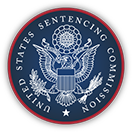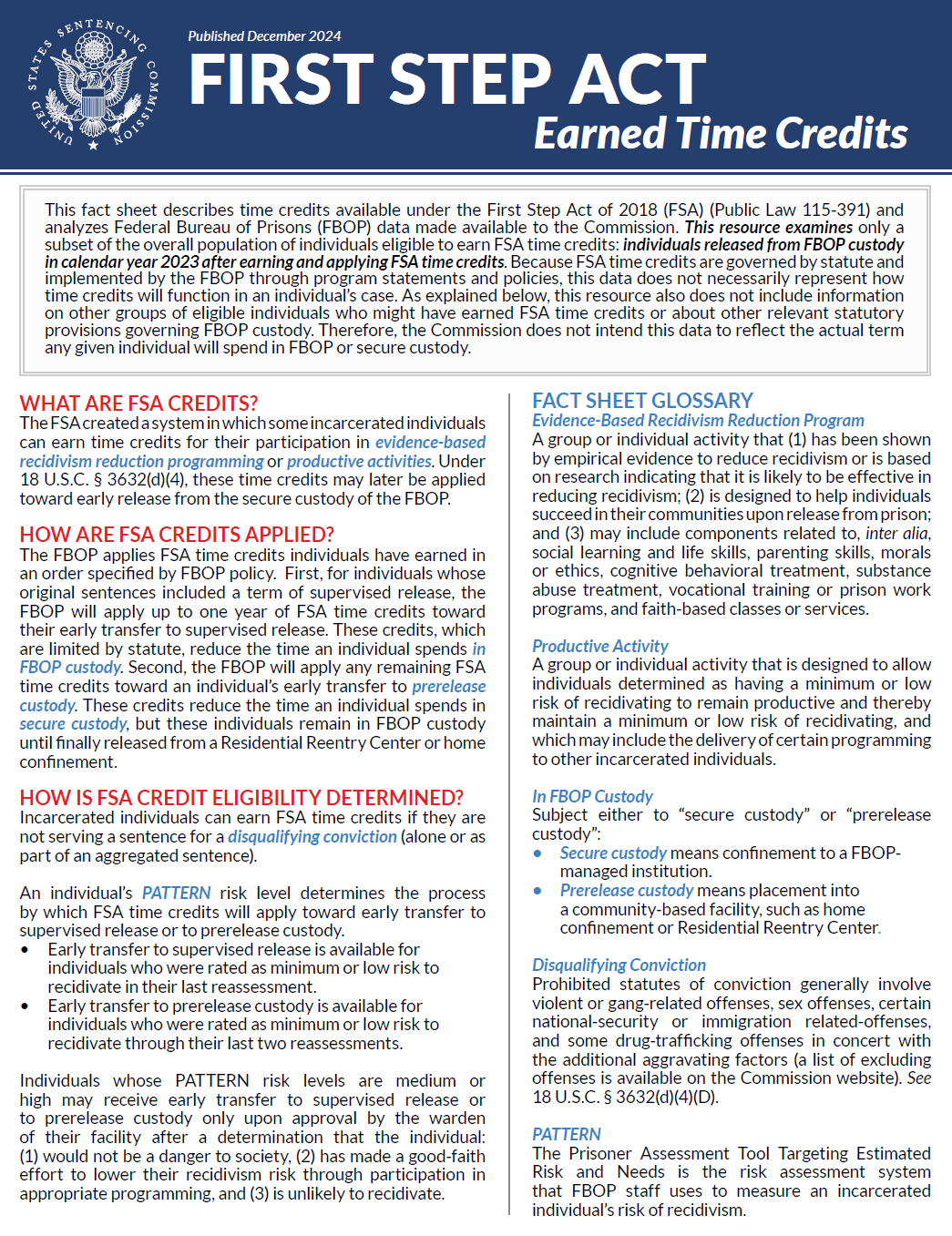Introduction
(Last updated December 11, 2024) The First Step Act of 2018 (Public Law 115–391) created a system in which some incarcerated individuals can earn time credits for participating in recidivism reduction programming or productive activities. Time credits can later be applied toward early release from secure custody. Eligibility criteria and rules for earning and applying time credits are governed by statute and implemented through BOP program statements and policies.
The Commission has published this page to assist in understanding the First Step Act and its current implementation, relying on primary source documents created by other government agencies. It is for informational purposes only and is not intended as legal analysis. The information does not necessarily represent the official position of the Commission and it should not be considered definitive or comprehensive.
Infographic. First Step Act Earned Time Credits
Calendar Year 2023 Data Snapshot
This section analyzes Federal Bureau of Prisons (FBOP) data made available to the Commission. The Commission examined a subset of the overall population of individuals eligible to earn FSA time credits: individuals released from FBOP custody in calendar year 2023 after earning and applying FSA time credits. Because FSA time credits are governed by statute and implemented by the FBOP through program statements and policies, this data does not necessarily represent how time credits will function in an individual’s case. This resource also does not include information on other groups of eligible individuals who might have earned FSA time credits or about other relevant statutory provisions governing FBOP custody. Therefore, the Commission does not intend this data to reflect the actual term any given individual will spend in FBOP or secure custody.
Access the Commission's findings in the menu below. Click the About the Data section to learn more about the Commission's methodology. A print-friendly version of this information is also available through the PDF link.
Key Takeaways
Location Prior to Release
Comparisons
About the Data
The Commission received data from the FBOP on 18,009 individuals who were released from FBOP custody in calendar year 2023 after they earned and applied FSA time credits. The study that follows this section included 17,465 individuals for whom complete FSA time credit data was available.
This fact sheet does not include information on certain groups of eligible individuals who have earned FSA time credits but remain incarcerated. Among these individuals are those who have earned FSA time credits but:
Who have not reached the release date resulting from application of the time credits;
Who are ineligible to apply the time credits earned because they are subject to a final order of removal; and
Who are ineligible to apply time credits because their PATTERN risk level is too high, and they have not otherwise been approved for application of their credits by the warden of their facility.
This dataset also does not include information on individuals who earned and applied FSA time credits and were released from FBOP custody prior to calendar year 2023.
FSA time credits are distinct from, and may apply in addition to, other credits or placement determinations available under federal law. For example, under 18 U.S.C. § 3624(b)(1), an individual serving a non-life term of imprisonment of more than one year may earn “good conduct time” credits, subject to a determination by the FBOP that, during each year of the sentence imposed by the court, the individual “has displayed exemplary compliance with institutional disciplinary regulations.” If the FBOP determines that an individual has not satisfactorily complied with institutional regulations, it retains the discretion to award lesser or zero good conduct time credits. As illustrated below, the FBOP calculates and applies good conduct time credits before it applies any earned FSA time credits; however, the actual impact of good conduct time credits on the length of an individual’s sentence is not represented in this fact sheet.
FSA time credits also are distinct from, and may apply in addition to, the credits and prerelease custody placement available for completion of the Residential Drug Abuse Treatment Program under 18 U.S.C. § 3621(e). Other provisions that affect the FBOP’s community corrections placement authority, and which may operate independently of FSA time credits, include: (1) 18 U.S.C. § 3624(c) (discretionary prerelease custody authority); (2) 34 U.S.C. § 60541(g) (elderly and terminally-ill individual home detention authority); and (3) section 12003(b)(2) of the Coronavirus Aid, Relief, and Economic Security Act (CARES Act home detention authority). The impact of these statutory provisions also is not represented in this fact sheet.
In addition to the data received from the FBOP on 18,009 individuals who were released in calendar year 2023 after they earned and applied FSA time credits, the Commission also received data on an additional 9,328 individuals who were serving a sentence for a disqualifying conviction and scheduled for release in calendar year 2023. These individuals were statutorily ineligible to earn FSA time credits.
Glossary of Terms
First Step Act
The First Step Act of 2018 (Public Law 115–391) was signed into law on December 21, 2018. The Act includes several requirements for the Department of Justice (DOJ) and its components, including the Bureau of Prisons (BOP), “related to developing and implementing a risk and needs assessment system, providing evidence-based recidivism reduction programs and productive activities to incarcerated people, and applying time credits” toward early release from secure custody. U.S. Gov’t Accountability Off., GAO-23-105139, 5 (2023).
First Step Act Earned Time Credits (ETC)
In addition to other awards and incentives, see 18 U.S.C. § 3632(d)(1)–(3), the First Step Act allows individuals to earn time credits that may reduce the amount of time they spend in secure custody, see 18 U.S.C. § 3632(d)(4). Incarcerated individuals may earn time credits “toward early transfer to prerelease custody (i.e., home confinement or Residential Reentry Centers) or to supervised release if they meet certain First Step Act eligibility requirements.” U.S. Gov’t Accountability Off., GAO-23-105139, 16 (2023).
PATTERN
The Prisoner Assessment Tool Targeting Estimated Risk and Needs is DOJ’s “risk assessment system” that BOP staff uses to measure an incarcerated individual’s risk of recidivism. U.S. Gov’t Accountability Off., GAO-23-105139, 11 (2023). Because risk factors vary based on whether an individual is male or female, PATTERN uses different “cut points” and evaluation criteria for each group. See id.; see also U.S. Dep’t of Just., Off. of Just. Programs, Nat’l Inst. of Just., 2022 Review and Revalidation of the First Step Act Risk Assessment Tool, NCJ 305720, 40–41 (Mar. 2023). More information about PATTERN can be found on the BOP’s website.
SPARC-13
The Standardized Prisoner Assessment for Reduction in Criminality is a 13-area “needs assessment system” that BOP staff uses “to identify incarcerated people’s needs that, if addressed, may reduce their recidivism risk.” U.S. Gov’t Accountability Off., GAO-23-105139, 13 (2023). These 13 need areas include anger/hostility, antisocial peers, cognitions, dyslexia, education, family/parenting, finance/poverty, medical, mental health, recreation/leisure/fitness, substance use, trauma, and work. Id. at 13–14 & n.28; see also BOP Program Statement 5400.01, First Step Act Needs Assessment 4 (June 25, 2021). “Different BOP units are responsible for assessing specific needs, some of which require the voluntary participation of the incarcerated person.” U.S. Gov’t Accountability Off., GAO-23-105139, 13 (2023). More information about SPARC-13 can be found on the BOP’s website.
Evidence-based Recidivism Reduction Program (EBRR)
An EBRR is a group or individual activity that (1) has been shown by empirical evidence to reduce recidivism or is based on research indicating that it is likely to be effective in reducing recidivism; (2) is designed to help individuals succeed in their communities upon release from prison; and (3) may include components related to, inter alia, social learning and life skills, parenting skills, morals or ethics, cognitive behavioral treatment, substance abuse treatment, vocational training or prison work programs, and faith-based classes or services. See 18 U.S.C. § 3635(3). The First Step Act Approved Programs Guide provides a listing and description of available EBRRs.
Productive Activity (PA)
A PA is a group or individual activity that is designed to allow individuals “determined as having a minimum or low risk of recidivating to remain productive and thereby maintain a minimum or low risk of recidivating,” and which may include the delivery of certain programming to other incarcerated individuals. See 18 U.S.C. § 3635(5). The First Step Act Approved Programs Guide provides a listing and description of available PAs.
In FBOP Custody
Subject either to “secure custody” or “prerelease custody”:
- Secure custody means confinement to a FBOP-managed institution.
- Prerelease custody means placement into a community-based facility, such as home confinement or Residential Reentry Center.
Table. Excluding Offenses for Earning First Step Act Time Credits
In some instances, a listed offense will exclude an individual only if specific or additional circumstances are present. These specific or additional circumstances are indicated in bold text in the Description column.

